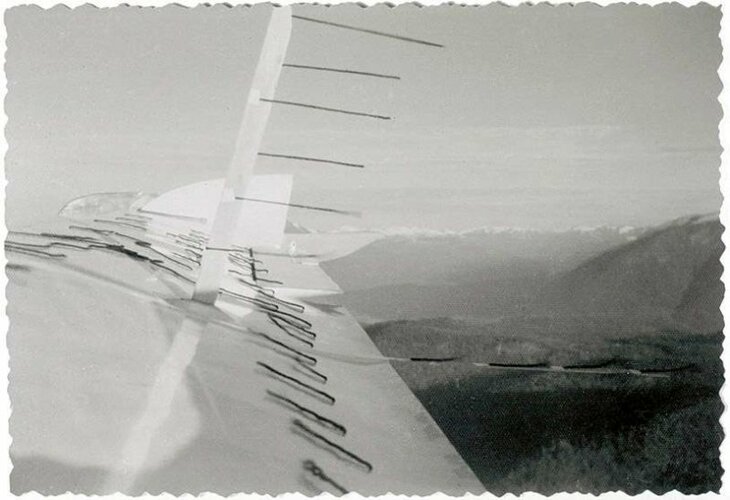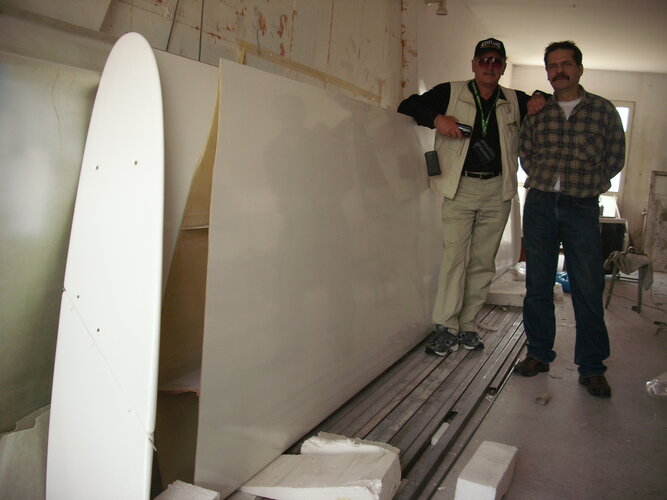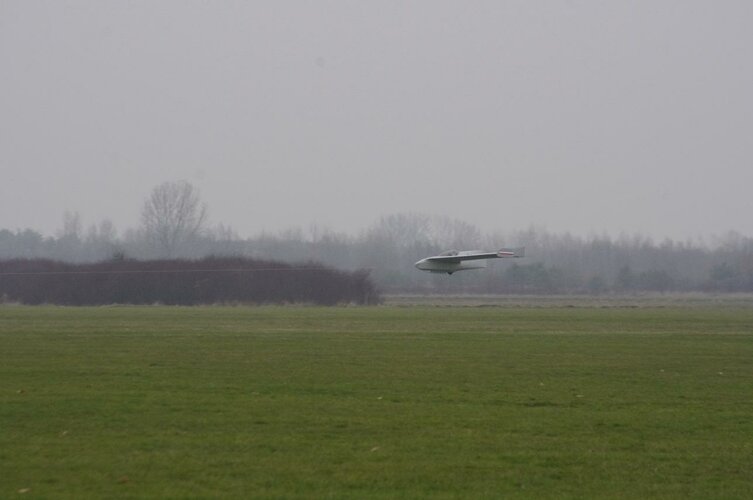More information on Witold Kasper is available at wikipedia, the TWITT and homebuiltairplanes.com websites.
Jasper was a controversial fellow, born and educated in Eastern Europe Poland and a talented glider pilot in his teens.
All of Kasper's airplanes were flying wings with a similar swept plan form. Pitch and roll was controlled by triangular elevons out at the wing tips. They all had vertical stabilizers on the wing tips. Wing tip mounted rudders controlled yaw.
Kasper contributed to the design of at least four flying wings that flew successfully. The first two were (wood and fabric) sailplanes built during the 1950s. BKB-1 sailplane is the best publicized and was built when Kasper worked in Montreal. BKB represents the names of the trio that built the prototype. It was a single-seater with conventional wood and fabric construction: Bodek, Kasper and Brochocki. Some sources credit Stefan Brochocki with the bulk of the design and Bodek with fabrication, while Kasper provided shop space and money. Kasper flew it from the glider port at Hawkesbury and took it to Washington state when he moved to Seattle.
Kasper's BEKAS had a fuselage similar to the BKB but a longer wingspan. Three BEKAS were built by 4 different men.
The third was a (tube and fabric) hang-glider that soon developed into a low-powered ultralight. Early Kasperwings had open cockpits but later versions were enclosed. Controls were unconventional. Pitch and roll were controlled by a trapezes (similar to Rogallis) but yaw was controlled by wingtip rudders. Dozens of Cascade Kasperwing I-80 ultralights were sold during the 1970s and a few still fly. Wikipedia has a page on Kasperwing ultralights.
"Vortex lift" is only generated at steep angles of attack. Like many delta wings, the BKB's leading edge acted more like a massive wingtip, generating massive spiral wingtip vortices. Kasper learned how to stabilize these vortices to generate massive amounts of lift at low airspeeds and steep angles of attack. This allowed steep descents, at low airspeed and survivable rates of descent ..... more like a parachute. Kasper sketched extra "vortex control panels" hinged to the leading edge. They lifted up - at steep angles of attack - to stabilize the leading edge vortex.
Kasper also theorized about similar "vortex control panels" - hinged to the top of the rear spar" - to control vortices above the trailing edge.
BKB-1 demonstrated controlled tumbling with the Center of gravity aft of normal. Lots of conventional airplanes can be tumbled when their C. of G. is too far aft, but very few are recoverable. BKB's advantage was that it tumbled straight ahead, maintaining the same heading, with little tendency to fall off to the side and spin. I suspect that leading edge sweep helped heading stability.
Hello, here I am am logging in years after you fellows have posted, so perhaps it's too late for you to retrieve my new posting. I just tried to submit one letter but I think I lost it having forgotten my ancient password; so here goes again: So much of what you have written above is untrue or misleading. Kasper (Kasprzyk) never designed the flying wing glider, the BKB. BKB stands for Brochocki, Kaspryzk, Bodek. Stefan Brochocki, my father, designed the glider in the 50's. His partners, Witold Kasprzyk, and Fred Bodek, all of Canadair Ltd, in Montreal, helped in the construction. Bodek assisted in the design of the mechanical controls to Stefan's specifications. Kasprzyk and Bodek probably did much of the construction as Stefan was spending most of his time on the design work and drawings as they proceeded. Kasprzyk left the project before it was finished as he moved to Seattle and eventually got work as a translator, not a designer, at Boeing. His self-promotional articles will tell you he was working in the design department. Technically he was; his translation desk was on the design floor in Payload (as told to me by a former Boeing employee).
The BKB was flight-tested outside of Montreal in about 40 flight tests done by Dave Marsden (aircraft designer/pilot), Dave Webb (Canadian gliding champion), and George Adams (pilot) as well as several others. Kasprzyk, now Kasper, was not involved in any of this. He was out of the country. I have copies of almost all of the reports, originals as well as the digitized copies I have been trying to make. It was noticed during testing that the BKB might be prone to tumbling, something Stefan had tried hard to avoid in the design. It was also noted that the glider had a strange capability of slow flight at high angles of attack. It mushed.
I have written a paper on the glider. I presented it when the FAA flew me out to Seattle in 2002 for the NWATS conference. I will make it available to anyone who wants it. Kasper revived his interest in the glider when he started hearing about its success. It had been featured in an OSTIV conference and publication in the 60s, in flight magazines, and The Worlds Sailplanes, (all attributing the design to Brochocki). He demanded his time with it as 1/3 owner. It was sent to Seattle where he was to continue testing it., but he chose to use it for stunt flying and publicity.
He patented the design (illegally). He used its drawings (illegally) as a template for a longer-winged version, the Bekas. 3 versions were built. They failed to have the performance he claimed. (I have heard this from many people familiar with the Bekas.) Because Kasper never engineered the design of the wing to accommodate the extra length, the glider was prone to severe torsional flexing. All crashed. One was recently shipped to Poland where it was rebuilt. Tragically it crashed on its maiden flight killing the pilot. I suspect you are all aware of that. The motorized wing illustration in one of the above posts was never more than that. It never got off the illustrator's drawing board. His other much-touted motorized craft with the "kasper" wing crashed on take-off. No witnesses except the pilot. He survived, but when I tried to contact him a few years ago, he was apparently suffering from some dementia and unable to provide any information. He sold the illegally patented wing concept to the late Steve Grossruck, who created a successful ultralight.
Kasper flew the BKB as a stunt plane though it was never designed nor approved for aerobatics in its Canadian certification process. How it got licensed for that in the USA is unknown. Kasper encouraged others to try flying it. One pilot tried one manouver too much and was killed when the wing flew off. At least that's how the story goes; there are no surviving witnesses, only Kasper's account of the pilot's having done a manouver Kasper had apparently forbidden him to do. Obviously.
The BKB did tumble successfully, but only nose-up. The film above may appear to show a nose-down tumble. That is my fault. I had a friend try to clean up the water- spotted film and add some dialog. He thought he was being helpful by reversing a segment of the footage to show the tumble in reverse. Big mistake. Then I sent the footage to a group in Poland while advising them not to circulate it because of the misleading footage. Another big mistake. Before I knew it, it was all over the internet. I also asked them to take it down. Too late. I haven't watched the one above so I don't know if the misleading footage is still there. Eyewitness reports of nose-down tumbling were misleading. Kasper apparently started those tumbles from an upside-down position, thereby completing the second half of a nose-up tumble before the first half so it appeared nose-down. There is no evidence of continuous tumbling.
There is more but, I'm tired. I will end by saying, careful what you read. The vortex stuff is also suspicious. I talked to the NASA engineer from the space program who witnessed the wind tunnel tests. (He was embarrassed after having asked Kasper to present to NASA.) A lot of it is pure hogwash. Today we would call it fake news, or perhaps Kasper's alternative facts.










